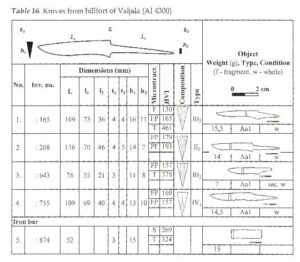Database
Our database is free to use for all history and archaeology enthusiasts. If you use our database, please do not forget to cite correctly:
Mägi, Marika; Palm, Piia Sandra. Archaeological Artefacts of Saaremaa. Foundation Osiliana / Tallinn University. Accessed: date.
The Osiliana Archaeological Database presents artefacts from Saaremaa and the surrounding small islands.
The database contains mainly Iron Age and Medieval finds that can be classified.
Undated metal or other pieces were generally excluded from the database.
Ceramics are represented by isolated examples.
The database is a work in progress and is constantly being updated.


Fragment of chisel.

Cross-shaped pendant. According to Tuuli Kurisoo’s classification subtype B1.6.2 that was widespread mainly in Saaremaa and West-Estonia. Several such pendants have been found in cremations in stone graves (Kurisoo 2021, 63-64). At the exhibition of Saaremaa Museum.
Literature:
Kurisoo, T. 2021. Adornment, self-definition, religion: Pendants of the north-eastern Baltic Sea region, 9th-13th century. Kiel/Hamburg: Wachholtz Verlag.

Valjala hillfort
Iron rivet. At the exhibition of Saaremaa Museum.

Valjala hillfort
Chain with S-shaped hook, bronze.

Knife.
Literature:
Peets, J. 2003. The power of iron. (Muinasaja teadus, 12). Tallinn, 245.
Valjala hillfort
Javelin head with knife-shaped blade and twisted neck. This weapon type was widespread in Saaremaa and coastal Estonia. Similar items have been found at Valjala, Pöide and Muhu hillforts as well as in stone graves, but also in 13th-century inhumation graves at Pada, North-Estonia.

Javelin head with knife-shaped blade and twisted neck. This weapon type was widespread in Saaremaa and coastal Estonia. Similar items have been found at Valjala, Pöide and Muhu hillforts as well as in stone graves, but also in 13th-century inhumation graves at Pada, North-Estonia. At the exhibition of Saaremaa Museum.
Literature:
Peets, J. & Valt, J. 2011. Ühest rauaaja lõpu relvast Saaremaal, Mandri-Eestis ja naaberpiirkondades. – Saaremaa Muuseum, kaheaastaraamat 2009–2010 (3–29). Saaremaa Muuseum, Kuressaare.

Valjala hillfort
Iron artefact, the end link of a big chain.

Knife.
Literature:
Peets, J. 2003. The power of iron. – Muinasaja teadus, 12. Tallinn, 245.

Valjala hillfort
Rudder? Found from the well.
The negative value refers to time Before Christ.






